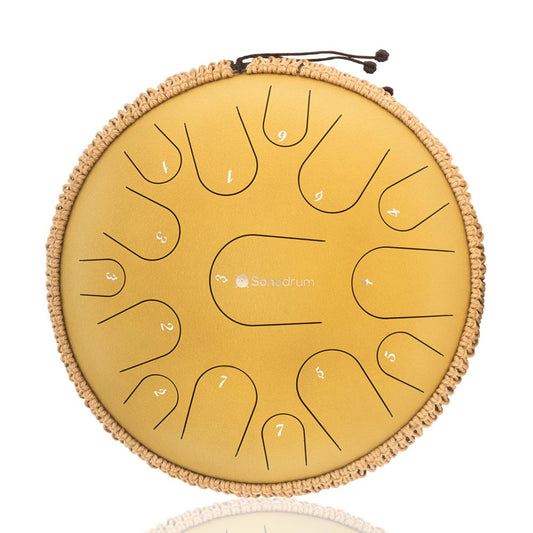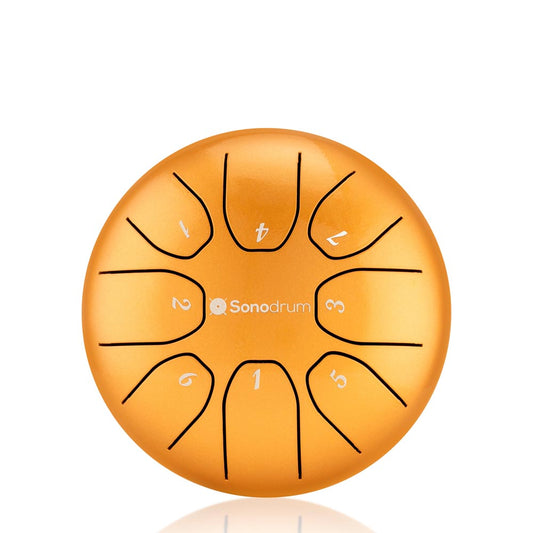Steel tongue drums are solid instruments that produce tones through the vibrations within them. Therefore, these drums belong to the family of idiophones. In simple terms: you strike the metal sheet with carved tongues, causing the drum to vibrate and produce different tones depending on the tongue.
But what if you want to retune the tongue drum?
A great feature of steel tongue drums is that some of them come with an adjustable scale, allowing you to change the key and scale to suit your mood.
How is a steel tongue drum tuned? - Tongue drums with adjustable tuning use a simple magnet system. By moving the magnets up or down on the tongues, you can either raise or lower the pitch. This way, you can choose the key and tune to any scale you want to play.
On the other hand, with other pre-tuned tongue drums that contain only one scale, like those found at Sonodrum, it's different. How can you retune these tongue drums? Is it even necessary?
Find out everything about retuning tongue drums, how each drum is tuned, and how you can prevent the pre-tuned drum from going out of tune over time. We're experts in the field, and you'll surely find many insights in this post. Enjoy reading!
How often should you maintain your tongue drum?
When purchasing a handpan or tongue drum, it's advisable to find suitable transportation for it. Options include hard and soft shell cases or a suitcase. As the name suggests, your instrument is better protected from impacts in a hard shell case, especially if it's a large handpan. For tongue drums, the carrying case included in our sets is usually sufficient. Consider how often you'll be transporting your instrument and the conditions it will be exposed to.
Almost all handpans and tongue drums require regular maintenance to protect them from rust. Most manufacturers recommend using handpan oil, coconut oil, or even car wax. Feel free to inquire with us individually to determine the best maintenance product for your lotus drum. Typically, you should wipe down the top and bottom of your instrument every 2-4 weeks with a maintenance product and a microfiber cloth.
Step-by-step guide to properly maintain your handpan
Maintaining a handpan or steel tongue drum is very simple but requires consistent and regular attention. To prolong the lifespan of the instrument, it should be wiped down immediately after each use (especially with nitrided models). Specifically for the maintenance of these instruments (handpan, steel tongue drum, tongue drum, steel drums), cleaning agents and microfiber cloths are available, allowing you to clean and protect them from corrosion.
Stainless steel handpan: A cleaning wax made from natural beeswax and organic rapeseed oil works wonders. It's advisable to regularly wax your handpan to maintain a thin protective layer and preserve the instrument's shine. This way, you can keep the handpan looking flawless for many years.
Stainless steel tongue drum: Made from stainless steel sheet, it shows no signs of corrosion. However, whether played by hand or with mallets, regular maintenance is still important to avoid dirt buildup, maintain shine, and ensure good tactile contact. Use a microfiber cloth and suitable oil to clean and maintain your Sonodrum monthly.
Painted or chromed steel: Steel tongue drums usually have a painted or chromed surface. They are made of mild steel and are therefore more susceptible to corrosion. It is important to pay special attention to ensure that the paint or coating does not wear off over time. To keep these instruments in good condition, regular maintenance is crucial. Simply clean the drum with a lightly dampened cloth, then dry it and polish it with another soft, clean cloth.
Tongue drum made of nitrided steel
Nitrided mild steel tongue drums are more susceptible to corrosion than other tongue drums. Regular maintenance of this drum is essential to provide lasting protection against rust and oxidation. Therefore, it must be treated regularly with a natural wax, oil, or other suitable maintenance product for this instrument. Look for appropriate handpan care and corrosion protection at specialty stores.
Retuning the tongue drum may also be necessary more frequently than with a steel tongue drum made of alloyed steel with a high-quality coating, such as those found at Sonodrum.
Rust has formed, what can you do?
If your handpan starts to rust, don't panic! Rust does not affect the sound of the handpan unless it becomes incredibly rusty (in which case you'd have to leave it out by the sea for many years).
Depending on the manufacturer, material, treatment, and location, you'll need at least a soft, clean, dry cloth and perhaps some of the following items:
- Alcohol
- Scrub sponge Rust
- removal polishing cloth
- Maintenance/protective oil
Step 1: Clean the Tongue Drum Wipe the handpan as usual with a clean, dry microfiber cloth. Alcohol is optional - apply a generous amount to a cloth and thoroughly clean all surfaces, inside and out.
Step 2 (optional): Scrub the Tongue Drum If you have a rust spot or stubborn stain on the drum, dampen the dark side of the sponge with a tiny splash of water and gently scrub over the rust. Remember that this can also remove the surface coating of the tongue drum, so be careful and use the sponge judiciously!
Step 3 (optional): Rust Removal on the Tongue Drum For slightly larger rust spots, the miracle cloth does exactly what it says - it works miracles! Gently rub the area in circular motions. While this will remove the rust, it will also remove the oxidation layer on the pan. If the miracle cloth removes this layer, the drum may have a plain surface without color where the cloth was used. However, it's important to remove the rust as it tends to spread once it starts.
Step 4: Clean the Tongue Drum Again If you've performed either Step 2 or 3 above, repeat Step 1 to remove any residue.
Step 5 (optional): Protect the Tongue Drum Drip a few drops of organic oil or oil specifically designed for handpans onto your instrument and work it into all surfaces with a second soft cloth. Let it sit for a few minutes.
Step 6: Wipe the Tongue Drum If using oil, wipe off any excess with a third dry, soft cloth, and enjoy your almost-new tongue drum again!
Retuning a stainless steel tongue drum
In general, there are several ways to retune tongue drums. You can manually adjust the tongues with a thin tool by bending them up and down. Some people even recommend heating the metal to influence the sound. However, we recommend using magnets as they do not damage the instrument and can be easily adjusted or removed.
How is the tone field of a tongue drum tuned? This is how you can retune your tongue drum, if necessary or if you desire a different pitch.
Get a Tuner
Do not attempt to tune the drum without a tuner, as it is nearly impossible to hit the correct frequency and pitch of each tongue without a reference. You can purchase any chromatic tuner at a music store or simply download a tuning app for your smartphone. Some tuners even allow you to select a scale and tune each note within that scale without manually selecting the notes. However, the manual method is considered more precise, as retuning a tongue drum is not as standardized as, for example, guitars and violins.
Choose Frequency and Scale
Did you know that frequencies can influence your body and even aid in recovery? At the same time, they can also harm you! That's why precision and choosing the right frequency and scale are so important. You can either stick with the standard scale of your drum and focus on perfecting the tones, or try changing the entire scale and experimenting with a new frequency.
Magnetic Tuning
Sonodrum tongue drums can be easily tuned with special magnets. For retuning the tongue drum, you can move the magnets from the edge of a tongue to the point where it merges with the rest of the drum body to adjust the frequency or change the pitch of a tongue. Usually, you cannot reach all available scales with this method, but changing some notes to play melodies in the intended scales is quite simple. If you need more diapasons, you will have to purchase drums in different sizes and designs.
Tuning with a "Knife"
Some musicians suggest retuning the tongue drum with a knife or something similar. The idea is to hook the tongues through the notch to bend them slightly and bring the frequency back to the starting point. You must be very careful and bend each tongue in small steps, then check the frequency with a tuner after each bend. This way, you can also adjust the frequencies and achieve different pitches for each tongue.
What does tuning a tongue drum cost?
If you prefer to leave the retuning of the tongue drum in professional hands, which is very understandable if you are new to the field, then you can expect prices ranging from 50 to 200 euros. This largely depends on the size of the drum and the degree or extent to which the tongue drum needs to be retuned.
Tips to consider before purchasing a tongue drum
Just like a piano or guitar, all handpans need to be retuned sooner or later. The question is: How often does a handpan need to be retuned? This largely depends on the "stress" to which the handpan is exposed. The greatest stress comes from direct sunlight, but of course, it also depends on how forcefully it is played.
Tongue drums purchased from Sonodrum are already tuned. You don't have to worry about retuning the tongue drum right away. This often saves you time and unnecessary costs.
Tongue drums made of high-quality alloyed steel with an optimally coated surface (Sonodrum drums) generally do not require as much attention to prevent rust. While they are not completely rustproof, they are extremely rust-resistant. Additionally, there are various alloys of stainless steel, and some are more rust-resistant than others.
Therefore, it is important to pay special attention to the appropriate scale and to choose a tongue drum that is easy to maintain and does not rust quickly. Then you don't have to worry about retuning the tongue drum right away!




